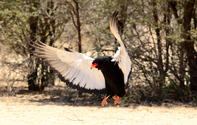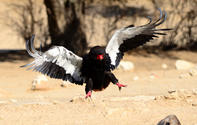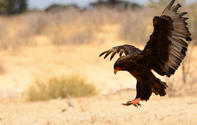The Acrobatic Eagle
The Bateleur’s name means marvellous face (Terathopius) without a tail (ecaudatus). They are striking eagles with contrasting black plumage, red bills and feet and a very short tail.
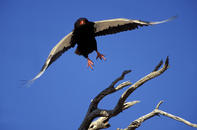
The word Bateleur is French for tightrope walker or acrobat due to the side-to-side rocking that results from its lack of tail-induced stabilization in flight.
Bateleurs are opportunistic feeders and being on the alert for meals to either scavenge, pirate or hunt, they fly low, 50-150 m above ground, zigzagging repeatedly over the same area. They will visit areas that have recently been burnt to harvest dead animals or they may follow roads to benefit from road kills.
At least a third of their diet includes much-varied hunted prey. The short tail reduces drag during their lengthy foraging flights, estimated at 400 km per day, and provides them with an element of manoeuvrability when they attack prey or in combat with other bateleurs.
Easy Identification
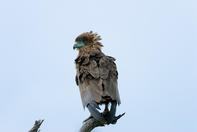
The Bateleur is one of the easiest raptors to identify in flight due to its tapering two-toned wings and up-turned primaries. Sexes can easily be told apart as the black trailing edge in females is much narrower than in males. When perched, female birds have a grey window on the wing below the grey shoulder which males lack.
It takes seven years for a bateleur to obtain its full adult plumage. Juveniles tend to have slightly longer tails, which shortens over successive moults and possibly helps initially to stabilize a young bird learning to fly.
Mates for Life
Bateleurs pair for life and aggressively defend a territory year-round diving at and even making contact with intruders on the back. They are well known for their dramatic aerial acrobatics associated with courtship during which the male dives headlong at the female who rolls onto her back and demonstrates her talons. Pairs maintain their bond through allopreening (mutual preening).
By Megan Emmet
